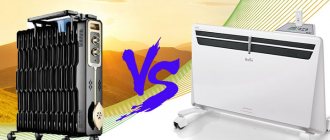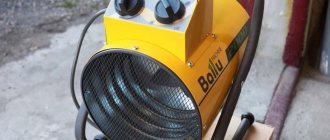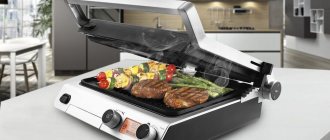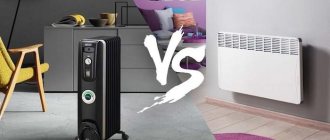In the off-season, when it is already cold and damp, sales of electric heaters increase sharply. The most popular types of appliances are convectors and fan heaters. They are inexpensive, compact, perfectly heat rooms and are in approximately the same demand.
And yet there is a significant difference between them. Let's figure out what is better - a convector or a fan heater for heating a house.
- Brief overview of the best brands
The type of heater matters
Fan heaters and convectors are often purchased for apartments in high-rise buildings, but sometimes they are also needed in houses. In an apartment, the heater serves as the main heating system in cold weather, and in a private house the owner can use it as an additional and/or alternative heating system.
The devices are also installed in rooms that require special temperature conditions (children's rooms, bathrooms, etc.).
Fan heaters are ideal if you need to quickly warm up the air. They are indispensable in the cold season at dachas, garages, workshops, etc. Convectors require more time, but their operation is more stable and energy consumption for heating is less
The basis for a meaningful choice of any device is an understanding of the principle of its operation, design, disadvantages and advantages. There is no ideal and universal technology, so you need to figure out which models are best suited for specific operating conditions. You should also decide on your own needs, priorities and expectations.
What's better to buy?
If you are faced with a choice: buy a convector or a fan heater, then you need to consider the following:
- If the heater is purchased for several years, then it is better to choose a convector. If you connect one network, it will be possible to heat several rooms at once. The main factor will be the presence of a thermostat with which you can adjust the temperature;
- If you need to quickly heat a room for a short period of time, then the choice is obvious - a fan heater;
- The best option would be to combine a convector and a fan heater. First, the first will quickly heat the air, and the second will maintain the required temperature.
In this article we tried to explain to you the difference between convectors and fan heaters. We also examined in detail all the advantages and disadvantages of these types of heaters, and the principle of their operation. All you have to do is decide what is preferable for you and make a purchase.
Fan heaters are effective, fairly cheap devices that quickly warm up the air. With their help, you can quickly restore a comfortable temperature in the room.
Convectors heat up more slowly, but operate more stably and require less energy to operate.
When choosing a fan heater or convector, you should consider the purposes for which the heater is purchased:
- for frequent and rapid heating of small rooms or local heating of objects, it is advisable to choose fan heaters;
- if equipment is needed to heat several rooms, preference should be given to convector units, since they are environmentally friendly, heat the air evenly and, if necessary, can be combined into a heating system.
Advantages and disadvantages of fan heaters
Fan heaters are inexpensive and efficient devices that are purchased for heating residential, administrative, and industrial premises. By choosing the right model, you can create a warm zone within a few minutes. To do this, you just need to point the fan heater in the desired direction and turn it on.
This is an excellent choice if you need to quickly warm the air in a separate area of the room. Such fan heaters are installed next to beds and work tables. They are also used if you urgently need to finish drying washed items.
Large stationary models are installed on the floor or mounted on walls, while mobile ones are easy to carry, rotate, and move to another location. The housings of the devices do not overheat, so there are no special requirements for surfaces. Fan heaters are placed on any floor coverings, tables, cabinets.
An ideal option for heating a living space or office during the off-season. The model can be installed so that it creates a thermal curtain at the entrance to the room or at the window
The principle of operation is simple: cold air enters a closed or open heating element, instantly warms up, and the fan throws it out. The result is the effect of a warm wind that blows across people and objects in the room. Heated air flows are mixed with cold ones, thanks to which a comfortable temperature is quickly established in the room.
Hot air moves forward - in the direction where the device is pointed, and then rises. The distance that the heat flow travels depends on the power and design features of the model
When choosing, they focus not only on the desired power and noise level, but also on the type of heating element. Depending on it, the following fan heaters are distinguished:
- Spiral . The heaters are made of spiral nichrome wire. In working condition, their temperature can reach 800°C. Despite their high efficiency, these heaters are considered not the best choice, because... During operation they burn dust and moisture. As a result, the air becomes dry and an unpleasant odor appears.
- Heating elements. The temperature of the heating element does not exceed 200°C, but this does not affect the quality of work due to its large area. The models are fireproof, convenient, but more expensive than spiral models.
- Ceramic . The elements heat up much less - up to 200°C, and do not burn out the air. They are absolutely safe and easy to use. This is the best choice for today. If you buy a model from a reliable brand, it will serve for a long time and without failure.
The advantages of fan heaters include compactness and high air heating speed. Almost all models are equipped with control panels for operating modes, temperature sensors, and some also have remote controls.
In some cases, uneven heating is a plus. If some area in the room needs more intense heating than others, you should choose a fan heater
Fan heaters also have disadvantages: noise during operation and uneven heating of the room. As for noise, it is impossible to completely solve this problem. The rotating fan blades will make sounds in any case. The noise may be greater or less, but it will always be there. You'll have to come to terms with this.
Brief overview of the best brands
In the rankings of the best manufacturers of fan heaters, the leaders are the same companies that produce the most reliable convectors: Ballu, Timberk, Vitek, Electrolux, Saturn, Polaris, AEG, NeoClima, Scarlett, Teplomash and others.
Image gallery
Photo from
Ballu and Timberk spiral fan heaters are considered the best in terms of price-quality ratio. These are reliable and easy-to-use devices that contain nothing superfluous. The only negative is that some models do not provide the ability to operate in regular fan mode
The range of Electrolux brand fan heaters is varied, but buyers pay special attention to wall-mounted units. They differ from analogues of other brands in their original design, compactness and ease of installation. The models are universal, suitable for installation in premises of any purpose, but sometimes you have to extend the cord, because... it's too short
If you are looking for a trouble-free floor fan heater, take a closer look at models from the Vitek and AEG brands. They are compact, efficient, nice looking and have many additional features that make them easier to manage. Some models can swivel, and all turn off when tipped over. Great option for home or office
Not many manufacturers produce fan heaters with heating elements. Among them, the Teplomash trademark deserves special attention. The models can hardly be called attractive, but they are excellent for heating spacious private houses and industrial premises. An additional advantage is that it can be used as a full-fledged powerful fan.
Ballu - inexpensive spiral models
Electrolux - the best wall-mounted models
Vitek – reliable floor fan heaters
"Teplomash" - the best heating element fan heaters
When choosing a fan heater or convector, it is worth considering that many of them are assembled in China. It is better to pay attention to manufacturers who strictly control product quality and buy models from those brands that have well-organized service centers.
Useful tips
Models with a ceramic heating element are more expensive. But they perform much better in operation.
In the store, look at the back panel of the device. If you see a sponge filter for coarse cleaning, then know that the air in the room will be much cleaner.
The optimal power of the device is from 1 to 3 kW. In order for the device to be easy and convenient to use, the power must be adjusted smoothly.
Read more: Which bathtub is better: acrylic or steel plumbing lasts longer
It makes sense to buy devices that have a well-thought-out security system. It should provide protection against overheating and will automatically turn off the device if it is suddenly knocked over.
A fan heater should be used to dry cottages after winter or in small rooms with drafts. The device is convenient when there is a need to warm up the room frequently and quickly.
Enterprises produce models of various types - gas, electric, water. However, practice has shown that electric convectors are more often on sale. These are the ones that Russian buyers prefer.
Gas or water models are also in demand. They are bought by those who have a house or dacha outside the city. These devices are less suitable for an apartment.
When choosing a device, pay attention to products under the brand of well-known manufacturers. It makes sense to choose a model with an electronic thermostat. After all, it will control temperature changes. Moreover, with an accuracy of 1 degree.
Electric convectors are very good for a small room with low or standard ceilings. When the ceiling height exceeds three meters, a fan heater is better. Better yet, several fan heaters. Then they will quickly warm the air and mix it. And as a result, strong cooling will not occur.
Convectors with a power from 0.25 to 2.5 kWe are good for home use. The power depends on the area of the room. There is a reason to find out in the store the heating temperature of the case. Let's say, to work in a children's room, the case needs to heat up to 55 degrees.
What type of heating device is better to choose?
It all depends on the goals of the owner of the premises. If you need to achieve uniform heating of the entire area, and speed is not important, then it is better to install a convector. If the main goal is to obtain a directed flow of hot air and instant heating of a specific area in the room, a fan heater would be the best choice.
You can easily install a fan heater in your home office or office. The measured hum of the blades will not interfere, but will only help you concentrate, cutting off external sound stimuli
In residential premises, convectors are often installed due to the lack of noise, and for an office, where there is always some sound, a fan heater is appropriate.
Operating principle of the convector
The principle of operation of a convector heater, regardless of the type of thermal energy source, is to use the quality of the gaseous medium to rise during heating, then cool down and fall.
An integrated heating element moves air through the unit from bottom to top. The heated air tends upward, giving off heat to the surrounding space of the room, then cools down and goes down.
Heat exchange is enhanced by the upward movement of heated air along a parabola. The air space in the room where the convector heater operates heats up to an acceptable temperature in 15-20 minutes.
Convectors are gas, electric, water. Gas ones are economical, but unsafe. Electric ones are easy to install, safe, but consume a lot of energy. Water ones are more difficult to install, but they are optimal from an economic point of view.
Types of convectors
- With electronic thermostat. They are silent. Disadvantages - price, failure due to power surges.
- With electromechanical thermostat. Immune to power surges. The disadvantage is a large error in measurements.
- Floor-standing. Mobile, you can easily move around the room.
- Wall-mounted. They have a small thickness and can be vertical or horizontal. Installed under windows. Due to their attractive appearance, they can be placed on walls.
- Ceiling. Mounted on the ceiling, often installed in dachas or country houses.
- Built-in. They are often mounted in floor niches and then covered with gratings.











